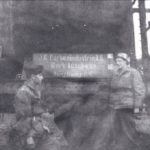On the 68th Anniversary of the Liberation of Auschwitz
by David P. Rosenberg, M.P.A., Reference Services Research Coordinator, Center for Jewish History
On January 27th, 1945, Auschwitz was liberated by the Red Army. The desolate, disease-ridden and mosquito-infested complex comprised the largest of the Nazi concentration camps. Over a million people were murdered there. When the Nazis learned of the Red Army’s approach, they attempted to evacuate Auschwitz. Starting on January 18th, 1945, they led about 65,000 people out of the camp on a death march. On the 24th, the last of the SS fled after attempting to destroy crematoria. When the camp was liberated, 7,000 people were found alive but were too weak to walk. Liberators also discovered over seven tons of human hair (which slave laborers had been making into thread); 830,000 women’s coats and dresses; and 348,000 men’s suits.
Looking at this date in the history of Auschwitz
On January 25th, 1940—five years, two days prior to the liberation of Auschwitz—the SS Commander-in-Chief was informed that: “A camp is soon to be erected near Auschwitz which is considered a kind of official concentration camp.”
Exactly a year later on this date, 20 prisoners arriving from Kattowitz received numbers 9520-9539. Many other prisoners were not processed and were instead led to the death chambers immediately.
Auschwitz was liberated two years after the U.S Army Air Force attacked Wilhelmshaven in the first all-American air raid on January 27, 1943. On this date in Auschwitz, abuse, illness and starvation brought 31 prisoners and 13 Russian POWs to their deaths. Those killed included one German criminal prisoner, one Jew, five Czechs and 24 Poles. (Also on the same day, in Poland, the underground resistance at the Pruzana Ghetto put up a fight when the Nazis learned of the resistance movement and attempted to deport 2,500 people to Auschwitz.)
On January 27th of 1944, 190 men were given numbers 172860-173049, and 69 Women are given 74902-74970. The remaining 689 of the original 948 from Westerbork, Holland were killed in the gas chambers.
Searching the catalog to learn about Auschwitz
Searching our catalog—search.cjh.org—for the term “Auschwitz” will reveal over 1,500 books and archival items. Many of these items, including the above photograph, have been digitized and can be viewed from anywhere with an internet connection.
The above photograph is from the Ernst Loew Collection, AR 7200, held by the Leo Baeck Institute. Born Ernst Loewensberg circa 1900-1905 in Ingelheim am Rhein, Loew emigrated to United States with family in the early 1930s. He served in the United States Army during World War II, and he collected material during his time in Europe. His collection also has camp money from Theresienstadt, anti-semitic propaganda flyers from France and Germany, and a shoulder patch from the Jewish Infantry Brigade Group in World War II.
To view photographs from the collection, click here.
To browse the entire Ernst Loew collection, click here.
According to Yad Vashem, “The Auschwitz Album is the only surviving visual evidence of the process of mass murder at Auschwitz-Birkenau. It is a unique document and was donated to Yad Vashem by Lilly Jacob-Zelmanovic Meier.” (Click here for more.)
There is additional information on the camp at the US Holocaust Memorial Museum encyclopedia page here.
See also the YIVO Encyclopedia of Eastern Europe entries Auschwitz Protocols and Killing Centers.
CJH Holocaust Resources: An Annotated Bibliography yields 188 detailed results from a search for “Auschwitz.” These results are from the archival holdings housed at the Center for Jewish History.
–
Sources
I consulted the following works to write this blog entry:
Czech, Danuta. Auschwitz chronicle, 1939-1945 / New York : H. Holt, c1990
The Holocaust and World War II almanac / Detroit : Gale Group, 2000.
The holocaust chronicle / Lincolnwood, Ill.: Publications International, c2000. – also available online by clicking here.
Wiesenthal, Simon. Every day remembrance day: a chronicle of Jewish martyrdom / New York : H. Holt, 1987.

